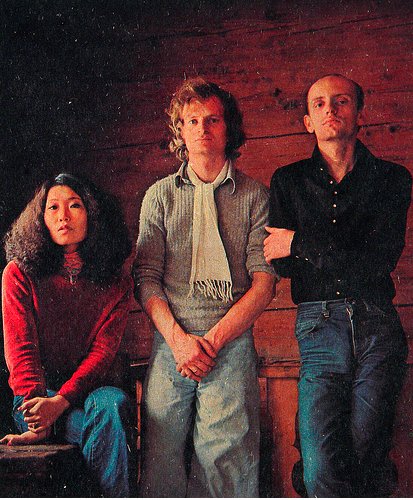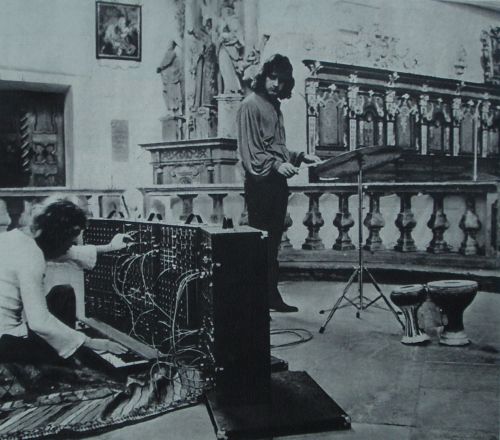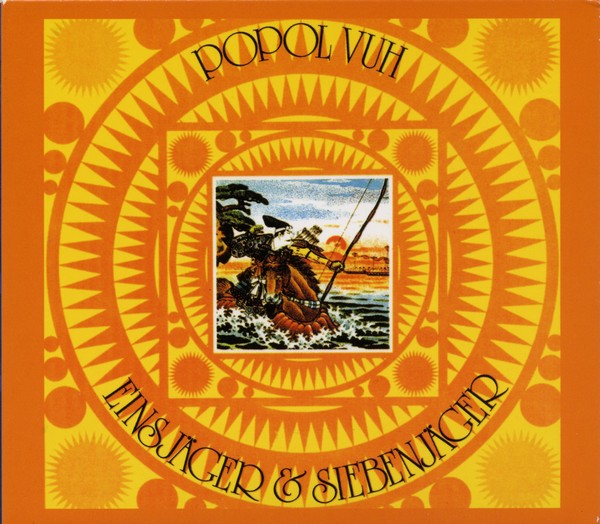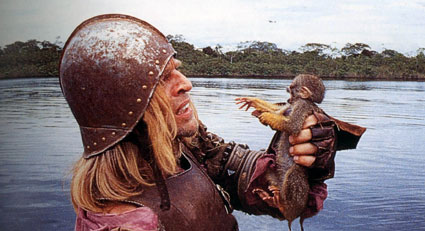Popol Vuh
 Toby Frith
Toby Frith  Saturday, September 27, 2008 at 08:53PM
Saturday, September 27, 2008 at 08:53PM 
Popol Vuh (L-R Djong Yun, Florian Fricke (note minimal scarf), Daniel Fichelscher)
LISTEN TO THE BLEEP43 PODCAST SPECIAL ON POPOL VUH
Earlier this year Austrian label Editions Mego released remixes of film music by German band Popol Vuh by Mika Vainio and Haswell and Hecker. It was an odd choice to say the least, today’s leading noise protagonists getting their chance to rework the catalogue of a group associated with the pioneering spirit of new age ambience and folk music, but this collision of dynamics, styles and different generations was remarkably effective, coming as a slow wave of recognition of this unusual and esoteric band gathers pace.
Of all the musicians and groups that emerged from the golden period of German music during the seventies, Popol Vuh remain the most mysterious and arguably the most at odds with the various aesthetics that homogenized these artists together apart from their nationality. The death of Florian Fricke, the band’s central figure, in 2001 means that we will not get a chance to hear much about their history from the main source, which apart from a handful of short interviews, remains somewhat fragmentary.
It is also difficult to detach their music from the close connection with the celebrated director Werner Herzog. Films such as Aguirre, Nosferatu, Heart of Glass and Cobra Verde were transformed by the ethereal scores that Fricke provided for him. Both grew up in Munich, shared a love of film and anthropology and would remain close friends, strengthening a connection across artistic fields that remains one of the most important of the quiet cultural revolution that engulfed West Germany during this time. Yet aside from this fruitful collaboration there remains a large back catalogue of remarkable work that spans a wide range of styles, from pioneering drone electronics to baroque chamber music.
Florian Fricke remains an enigmatic figure. Arguably something of an archetypal and thus contradictory hippie, he garnered a reputation for being a loner and difficult to deal with, so it is perhaps not unusual that he would be so close to Herzog. Central to his core beliefs were his interests in religion and philosophy. The band’s name comes from a text that both him and Herzog were fascinated by in their youth, namely the “Popol Vuh”, an ancient Maya mythological text that roughly translates as “Book of the Community”, but also can be read as “A Gathering under the sign of the Sun”. During his formative years Fricke travelled extensively in Asia, taking time to learn the methods of Tibetan Buddhist Chanting, a technique that he incorporated into his work later. He is said to have converted to Christianity and Hinduism at the same time during the early seventies, but interviews with him seem to bear out the notion that his was much more of a personal perspective on religion itself rather than adhering to a particular creed or denomination, and that he was keen to distance himself from the controlling aspect of worship.
For all his adherence and belief in older traditions and being somewhat conservative in nature, it is then all the more remarkable that Fricke was an electronic music pioneer. Having been something of a child prodigy with the piano, in 1969 he became the proud owner of the first ever Moog III synthesizer in Germany, a huge modulated version that he would play constantly day and night looking to create sounds as there were no instructions with the equipment. For Fricke the ability to reproduce sounds that did not come from traditional instrumentation led him to believe that these were noises that came from within himself, rather than through his hands.
Curiously enough the one other person who owned one was his neighbour, fellow musician Eberhard Schoener who had earlier introduced him to the possibilities of electronic instrumentation. Word of Fricke’s use of this strange new piece of equipment spread fast, not least to United Artists, whose German representative Gerhard Augustin travelled to Munich to offer him a record deal. Fricke recruited Frank Fielder and percussionist Holger Trülzsch for the recording of their debut album Affenstunde, which is amongst the first purely electronic albums ever made. Central to the sound of this is without doubt the colossal Moog, although unlike other music of the time, it never dominates, rather providing an eerie backdrop to a series of abstract ambient sketches that feature strong elements of eastern percussion, the final 18 minute long title track giving a hint of the cinematic aspects of Fricke’s intentions with his music.

(Fricke and Fielder in Stiftskirche, Baumburg)
In 1972 they released In den Gärten Pharaos, an album that stands the test of time as one of their true masterpieces, and a cornerstone in the history of electronic music. Composed purely of two songs that take up both sides (This was one of the first albums released in such a format) and recorded in a cathedral, it is an overwhelming and sometimes apocalyptic journey that is one of the first true pieces of drone music, and I would argue has never been bettered. The first half is composed of four segments, each with no definitive element of narrative or progression, but mesmerising all the same, some of these musical sketches being reprised in Herzog’s soundtracks later. From an eerie and mysterious beginning it transforms into some quite joyous, with Fricke’s electric piano providing a warm yet somewhat distant counterpoint to the percussion. As the track ends, sounds of water cascade slowly away, leading into the beginning of the second track “Vuh” which starts immediately with a sustained Organ that not only never dies, but is physically immense in its sound, magnified by the acoustics of the Cathedral. Slowly but surely percussion such as gongs and timpani build it to a fantastic hypnotic climax. This is the first time we hear something “spiritual” in Fricke’s music, but at this stage ironically it seems that his attention to religious belief would come later. I would argue that there is something sepulchral about this music. Cathedrals and Churches can be places of great art and beauty, but amongst the cold stone and the tombs one can also sense mortality and fear, and In den Gärten Pharaos reflects this mixture in a profound way. Yet by the time the album had been released, Fricke was no longer satisfied with the sound of the Moog, and felt that it or indeed the possibilities of electronic equipment did not suit the direction that he wanted to take his music in. He would use it to record with Gila and Tangerine Dream (on Zeit), compose some instrumental pieces that would later be used by Herzog and then gave it to Klaus Schuzle in 1975.
“I found a certain womanvoice on the synthesizer on the second LP and after that I was no longer interested. I’m a conservative artist, not interested in just pressing buttons, so I went back to the piano. Sometimes the power would vary so you couldn’t always get the same sound on the synthesizer. It’s too dependent on the machinery. It’s nothing human. The piano is more direct. People said I should continue because I could make money, but for me at that time electronics were over.”(Florian Fricke interview in Sounds, 1981)
At the end of 1972 Popol Vuh released what is considered by many to be their greatest record, Hosianna Mantra. Fricke unveiled a new line-up that included Conny Veit, who he had collaborated with on Gila’s Bury My Heart at Wounded Knee, and a young South Korean soprano called Djong Yun, the daughter of Isang Yun, a composer who had been caught up in an international kidnapping incident and had fled to West Berlin. The record reflects Fricke’s desires to bridge the gap between Western and Eastern religions, invoking the idea of Mass and Meditation, Hosianna and Mantra. With the monolithic Moog now gone, Popol Vuh were stripped down to simple piano, guitar phrasing from Veit that followed Indian scales and the pure voice of Yun with additions from oboe and tambura in the background. Hosianna Mantra delivers a masterful atmosphere of introspective elegaic beauty that comes direct from Fricke’s own heart. He intended for the album to be very much like a Mass, and its structure follows this, evoking a Renaissance feeling to the music. From the instrumental “Ah!” at the beginning to “Kyrie” and the title track, there is a timeless feel to the music that is contrapuntal in nature, having no strict adherence to modern motifs or rhythms, laced with Eastern inflections.
“In a way it was a Mass, a church Mass. But not for church! A conscious reflection upon religious origin is included in this music, but not in particular to any religious groups. Behind all of that I was convinced that basically all religions are the same. You always find it in your own heart. And the music of Hosianna Mantra is really touching your heart. It is made to touch your heart. That is why you can call it a Mass. A Mass for your own heart.” (Florian Fricke interviewed by Gerhard Augustin in 1996)
Fricke’s devotion to his art had approached its zenith at a comparatively young age, having successfully merged the two distinct strains of Western and Oriental religious ideals and musical traditions and transforming them into something new yet timeless. Listening to Hosianna Mantra distills a feeling of utter tranquility, and at times it is hard not to be sucked into feeling every single note that is uttered from his piano. The album was received to rich critical acclaim, and a new strain of music, namely “New Age”, had begun.
Popol Vuh, now joined by the presence of guitarist and drummer Daniel Fichelscher from Amon Duul II, released 3 short albums (none is more than 35 minutes long) devoted to Holy Books between 1973 and 1975. Seligpresung, Einsjäger & Siebenjäger and Das Hohelied Salomos.
The first lacks Yun’s vocals, and as such is weaker for it as Fricke ‘s own sadly were never going to match her range, and whilst the addition of more traditional western rhythmic impulse from Fichelscher creates an extra energy level for the music, it never reaches the giddy heights of its predecessor.

They returned to form with the magisterial Einsjäger & Siebenjäger, which was the true start of a musical relationship between Fichelscher and Fricke that would continue until the latter’s passing, reducing to a trio alongside Yun. Both complement each other in the contrapuntal style that emerged during the recording of Hosianna Mantra, and at times there’s a feeling that both are going off into unexplored regions, but more than anything else this is a development of the addition of rhythm that had started on the previous album. The impact of Fichelscher’s rock-orientated influence comes to the fore immediately as this is the first of 3 albums that bear his signature style of guitar playing and the muscular drumming he brought to Amon Duul II previously. In fact it’s really his album, the drumming and guitar almost overshadow Fricke’s piano, which whilst providing a solid backbone, seems happy to let him take the lead. Despite the general upbeat feeling of the album, there is still time for comtemplation and also the emergence of a signature song that would reappear again in Popol Vuh’s music, Fichelscher’s “Kleiner Kreiger” (Little Warrior). The remastered 2004 album contains a bonus track in the shape of the unearthly “Wo Bist Du?”, where Yun’s vocals are at their very best.
Das Hohelied Salomos (The Song of Solomon) completes this trilogy. A more controlled and less expansive affair, the mood is somewhat subdued, almost melancholic at times, but with Yun’s vocals much more pronounced. Of the 3 albums it’s the most emotional, changing moods regularly. The modal sounds of Indian Instrumentation return in the shape of sitar and tabla, and this time Fricke’s piano takes the lead is which why the album in general has an orderly feel about it. It contains one of their most beautiful songs, “Ja Deine Liebe Ist Susser Als Wein” and is a fine, contemplative end to a trio of superb records.
For Letze Tage, Letze Nacht another of Amon Duul’s ex-members joined, namely singer Renate Knaup. This is the closest we get to Popol Vuh being a rock band, the album starting with furious guitar playing in “Der Grosser Kreiger” which is reminiscent of King Crimson. Whilst there are aspects of this album that appeal, it has the hallmark of Knaup and Fichelscher’s previous band, and as such the meditative aspect of previous albums is subdued to the point of non-existence. Appropriately it would be the last album in this vein.

(Klaus Kinski in Werner Herzog’s Aguirre, der Zorn Gottes)
Fricke had already contributed music to several of Herzog’s films, notably “Even Dwarfs started Small” and “Die grosse Ekstase des Bildschnitzers Steiner” (which sadly remains unreleased), but would come to international attention with the ghostly soundtrack to “Aguirre, der Zorn Gottes”, Herzog’s magnum opus, released in 1972. Film critic Roger Ebert wrote “The music sets the tone. It is haunting, ecclesiastical, human and yet something else…The music is crucial to Aguirre.”
By all accounts the idea of Fricke and Herzog working together despite their friendship should not have worked. Fricke a difficult loner, Herzog notorious for his love of conflict, but they both shared a cinematic vision.
“Sometimes he (Herzog) came to my house and he asked please open your box, where I have my tapes from my productions. When we are listening to music, sometimes he lifts his finger and says “this part of your music would be great music for a film”. The music would be recorded very quickly after the film had finished, sometimes recording throughout the night.” (Florian Fricke interviewed by Gerhard Augustin, 1996).
Popol Vuh would contribute music to several more films by Herzog, most notably Herz Aus Glass, Nosferatu and Cobra Verde. Of the three, the middle offering is the most haunting, Fricke providing a quite unnerving soundtrack of Eastern chanting, Indian tablas and other motifs from previous works that were reprised (Der Kleiner Kreiger etc) for a film that, like Aguirre, is dominated by the unworldly cinematic vision of his music. Confusingly, some of the music used on Nosferatu (which originally had two separate releases to add to the confusion!) would also appear on their next studio album Brüder des Schatttens, Söhne des Lichts in 1978.
With Robert Eliscu returning to the frame, this was a journey back to the serene form of Hosianna Mantra. Whilst both it and the following LP Die Nacht der Seele (both albums were reissued as one called Tantric Songs) don’t quite match the melodic delights or verve of previous works, they are full of guitar, piano and oboe working in relaxed harmony, Fichelscher no longer quite so dominant or energetic. The title track of the former is an 18 minute epic that starts with eastern chanting before relaxing into a quite glorious sun-soaked simplistic interplay of the 3 players that never strays too far from a particular melodic idea, almost verging on hypnotic repetition.
Djong Yun left afterwards, Renate Knaup taking over permanently on vocal duties throughout the 80’s. Of this period, the album Agape Agape Love Love stands out, featuring a more “worldly” approach mixed with delightful simple piano from Fricke, the eastern influence slowly but surely ebbing away. Their soundtrack to Herzog’s Cobra Verde also features a return to electronics, Fricke producing some lush soundscapes for “Einer Andere Welt”, although it was clear that he still wasn’t particularly comfortable with using such equipment.
“It was due to the sampling technology. Where it is possible to store
nautral sounds working with electronics in the studio is now possible,
before it wasn’t. But that has really nothing to do with whether or not
I value the ‘electronic’sound. I actually don’t, because it is foreign
to all spiritual vibrations. It is like a person without a shadow.” (Florian Fricke in conversation with A.Luviano-Cordero 1995)
Overall though, the quality of their material until Fricke’s passing doesn’t match the quality of their golden period, with the odd song making an impact. Fricke’s last projects were multimedia orientated, the final one being a video installation at the Times Zone Festvial in Bari in 1998 for the album Messa di Orfeo.
Given their decision to eschew two fundamental aspects of modern popular music, namely electronics and rhythm, it is not surprising that Popol Vuh remain something of a mystery. They seem oddly out of time and place with everything associated with modern culture, and I often feel that listening to their music transports one to somewhere different, somewhere timeless and untouched by our generation’s hand. They begat “new age music”, but it is often the case that in the shadows of great pioneers is where poor imitations follow. Like all great artists, they ultimately defy classification.
I’ve been intrigued by Fricke’s religious devotion, and how that has been a catalyst for some of the most beautiful music I’ve had the pleasure of hearing. Living as we do in a modern culture where religion seems out of place and at odds with everything around it, Popol Vuh’s ego-less meditative beauty seems anachronistic yet enrichened by this, being a musical jewel awaiting to be discovered. Their influence on the history of electronic music isn’t as strong or direct as some of their contemporaries, but there is no doubt that they are a key component.
Toby Frith

Fricke passed away in his sleep after a short stroke in December 2001 at the age of 57. Werner Herzog provided a fitting tribute.
“Jokingly, we often said that he must never grow old, he who looked like a youth as we know them only from ancient Greek statues. Now he is with us no longer, and it’s like a tear right through the heart that Florian Fricke died much too soon. To me, Klaus Kinski was my dearest enemy, my best friend so to speak, but Florian Fricke Kept the balance, he knew a safe way across the abyss, when it came to creative work, he was my dearest friend.
And yet- regardless of outward appearance – he was a highly complex being, intricately spun and vulnerable, like a spider’s web. In reality, he was a poet first and a musician second, a composer. His feel for the inner narrative of a cinematic story was infallible, and his music had the ability to change our perspective as onlookers, even though a picture always remains the same projection of light in the cinema. He made visible what would otherwise have remained mysterious and forever hidden in the images. What is more, he had a talent for composing music that created whole new spaces, in concrete terms: landscapes that gain an unknown dimension which would not be accessible otherwise.
Only recently I came across a wonderful piece of music by him, which I had the privilege to use in a new film – grand orchestra, choir, and among the choir also his voice. I hear it sounding so clear and isolated as if he were the only singer, as if he were standing right next to me. Deeply moved, I tried to persuade my self it was only a rumour that Florian is no longer on this planet, but then a strange certainty prevailed: in a way he is still among us, with his voice, his music – albeit hidden, distant. He has not truly left us.”
Please visit this excellent Popol Vuh website and my thanks to Dolf Mulder for collating information on them.

Reader Comments (9)
nice article, toby - thanks!
Really good article. I enjoyed it very much.
This is a great summary, thanks for writing it. I only recently discovered Popol Vuh's music and instantly fell in love with it. There really is a sense of mystery about the band and your phrase 'ego-less meditative beauty' totally sums it up.
It's a good article, and podcast.
brilliant article.
adds a lot for me, helping to contextualise some albums i have been really enjoying recently
laulach e3d3fd1842 https://wocfolx.com/rafloposer
laulach e3d3fd1842 https://wocfolx.com/rafloposer
ottaquynn d4f391380b https://cdn.thingiverse.com/assets/ad/71/79/bb/21/BootIt_Bare_Metal_V118_With_Key_TorDigger_Download_Pc.html
edmele d4f391380b https://cdn.thingiverse.com/assets/79/8e/27/28/7e/gra_strzel_sobie_2_download.html